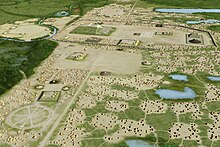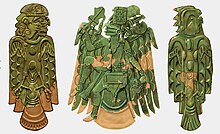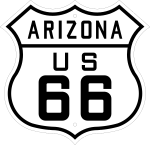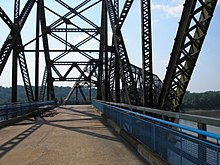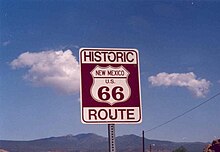| Cahokia Mounds State Historic Site | |
|---|---|
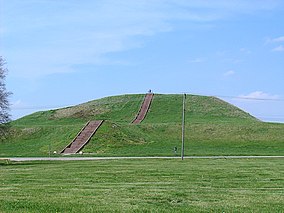
Monks Mound, the largest earthen structure at Cahokia (for scale, an adult is standing on top)
| |
| Location | St. Clair County, Illinois, U.S. |
| Nearest city | Collinsville, Illinois |
| Coordinates | 38°39′14″N 90°3′52″WCoordinates: 38°39′14″N 90°3′52″W |
| Area | 2,200 acres (8.9 km2) |
| Governing body | Illinois Historic Preservation Agency |
| Official name | Cahokia Mounds State Historic Site |
| Type | Cultural |
| Criteria | iii, iv |
| Designated | 1982 (6th session) |
| Reference no. | 198 |
| State Party | United States |
| Region | Europe and North America |
| Official name | Cahokia Mounds |
| Designated | October 15, 1966 |
| Reference no. | 66000899 |
| Official name | Cahokia Mounds |
| Designated | July 19, 1964 |
The Cahokia Mounds State Historic Site /kəˈhoʊkiə/ (11 MS 2) is the site of a pre-Columbian Native American city (which existed circa 1050–1350 CE) directly across the Mississippi River from modern St. Louis, Missouri. This historic park lies in western Illinois between East St. Louis and Collinsville. The park covers 2,200 acres (890 ha), or about 3.5 square miles (9 km2), and contains about 80 mounds, but the ancient city was much larger. At its apex around 1100 CE, Cahokia covered about 6 square miles (16 km2) and included about 120 manmade earthen mounds in a wide range of sizes, shapes, and functions. In population, it may have briefly exceeded contemporaneous London.
Cahokia was the largest and most influential urban settlement of the Mississippian culture, which developed advanced societies across much of what is now the central and southeastern United States, beginning more than 1,000 years before European contact. Today, Cahokia Mounds is considered the largest and most complex archaeological site north of the great pre-Columbian cities in Mexico.
Cahokia Mounds is a National Historic Landmark and a designated site for state protection. It is also one of the 24 UNESCO World Heritage Sites within the United States. The largest prehistoric earthen construction in the Americas north of Mexico, the site is open to the public and administered by the Illinois Historic Preservation Division and supported by the Cahokia Mounds Museum Society. In celebration of the 2018 Illinois Bicentennial, the Cahokia Mounds were selected as one of the Illinois 200 Great Places by the American Institute of Architects Illinois component (AIA Illinois) and was recognized by USA Today Travel magazine, as one of AIA Illinois's selections for Illinois 25 Must See Places.
History
Development
A
map showing approximate areas of various Mississippian and related
cultures. Cahokia is located near the center of this map in the upper
part of the Middle Mississippi area.
Although some evidence exists of occupation during the Late Archaic period (around 1200 BCE) in and around the site, Cahokia as it is now defined was settled around 600 CE during the Late Woodland period. Mound building at this location began with the emergent Mississippian cultural period, about the 9th century CE. The inhabitants left no written records beyond symbols on pottery, shell, copper, wood, and stone, but the elaborately planned community, woodhenge, mounds, and burials reveal a complex and sophisticated society.
The city's complex construction of earthen mounds required
excavation, movement by hand using woven baskets, and construction
involving 55 million cubic feet of earth, much of which was accomplished
over a matter of just decades. Its highly planned ceremonial plazas
sited around the mounds with homes for thousands connected by laid out
pathways and courtyards suggest the location served as a central
religious pilgrimage city.
The city's original name is unknown. The mounds were later named after the Cahokia tribe, a historic Illiniwek
people living in the area when the first French explorers arrived in
the 17th century. As this was centuries after Cahokia was abandoned by
its original inhabitants, the Cahokia tribe was not necessarily
descended from the earlier Mississippian-era people. Most likely,
multiple indigenous ethnic groups settled in the Cahokia Mounds area
during the time of the city's apex.
Historian Daniel Richter notes that the apex of the city occurred during the Medieval Warming Period. This period appears to have fostered an agricultural revolution in upper North America, as the three-fold crops of maize, beans (legumes), and gourds (squash) were developed and adapted or bred to the temperate climates of the north from their origins in Mesoamerica. Richter also notes that Cahokia's advanced development coincided with the development in the Southwest of the Chaco Canyon
society, which also produced large-scale works in an apparent socially
stratified society. The decline of the city coincides with the Little Ice Age, although by then, the three-fold agriculture remained well-established throughout temperate North America.
Rise and peak (13th century)
Cahokia became the most important center for the people known today as Mississippians. Their settlements ranged across what is now the Midwest, Eastern, and Southeastern United States. Cahokia was located in a strategic position near the confluence of the Mississippi, Missouri, and Illinois Rivers. It maintained trade links with communities as far away as the Great Lakes to the north and the Gulf Coast to the south, trading in such exotic items as copper, Mill Creek chert, and whelk shells.
Artists recreation of central Cahokia. Cahokia's east-west baseline transects the Woodhenge, Monk's Mound, and several other large mounds
Mill Creek chert, most notably, was used in the production of hoes, a
high demand tool for farmers around Cahokia and other Mississippian
centers. Cahokia's control of the manufacture and distribution of these
hand tools was an important economic activity that allowed the city to
thrive. Mississippian culture pottery and stone tools in the Cahokian style were found at the Silvernale site near Red Wing, Minnesota,
and materials and trade goods from Pennsylvania, the Gulf Coast and
Lake Superior have been excavated at Cahokia. Bartering, not money, was
used in trade.
At the high point of its development, Cahokia was the largest urban center north of the great Mesoamerican cities in Mexico and Central America. Although it was home to only about 1,000 people before circa 1050, its population grew rapidly after that date. According to a 2007 study in Quaternary Science Reviews,
"Between AD 1050 and 1100, Cahokia's population increased from between
1,400 and 2,800 people to between 10,200 and 15,300 people". an estimate that applies only to a 1.8-square-kilometre (0.69 sq mi) high density central occupation area. Archaeologists estimate the city's population at between 6,000 and 40,000 at its peak,
with more people living in outlying farming villages that supplied the
main urban center. In the early 21st century, new residential areas were
found to the west of Cahokia as a result of archeological excavations,
increasing estimates of area population.[23]
If the highest population estimates are correct, Cahokia was larger
than any subsequent city in the United States until the 1780s, when Philadelphia's population grew beyond 40,000.[24]
Moreover, according to some population estimates, the population of
13th-century Cahokia was equal to or larger than the population of
13th-century London.
One of the major problems that large centers like Cahokia faced
was keeping a steady supply of food. A related problem was waste
disposal for the dense population, and Cahokia became unhealthy from
polluted waterways. Because it was such an unhealthy place to live, Snow
believes that the town had to rely on social and political attractions
to bring in a steady supply of new immigrants; otherwise, the town's
death rate would have caused it to be abandoned earlier.
Decline
Mississippian
period showing the multiple layers of mound construction, mound
structures such as temples or mortuaries, ramps with log stairs, and
prior structures under later layers, multiple terraces, and intrusive
burials
The population of Cahokia began to decline during the 13th century, and the site was eventually abandoned around 1300. The area around it was not reoccupied by indigenous tribes until around 1350.
Scholars have proposed environmental factors, such as overhunting,
deforestation, and flooding, as explanations for abandonment of the
site.
Another possible cause is invasion by outside peoples, though the
only evidence of warfare found are the defensive wooden stockade and
watchtowers that enclosed Cahokia's main ceremonial precinct. There is
no other evidence for warfare, so the palisade
may have been more for ritual or formal separation than for military
purposes. Diseases transmitted among the large, dense urban population
are another possible cause of decline. Many theories since the late 20th
century propose conquest-induced political collapse as the primary
reason for Cahokia's abandonment.
Together with these factors, researchers found evidence in 2015
of major floods at Cahokia, so severe as to flood dwelling places.
Analysis of sediment from beneath Horseshoe Lake has revealed that two major floods occurred in the period of settlement at Cahokia, in roughly 1100–1260 and 1340–1460.
Notable features
The original site contained 120 earthen mounds over an area of 6 square miles (16 km2),
of which 80 remain today. To achieve that, thousands of workers over
decades moved more than an estimated 55 million cubic feet [1,600,000 m3] of earth in woven baskets to create this network of mounds and community plazas. Monks Mound, for example, covers 14 acres (5.7 ha), rises 100 ft (30 m), and was topped by a massive 5,000 sq ft (460 m2) building another 50 ft (15 m) high.
Monks Mound
An 1882 illustration of Monks Mound showing it with fanciful proportions
Incised sandstone tablet of a Birdman found in 1971 during excavations into the east side of Monks Mound
Monks Mound is the largest structure and central focus of the city: a massive platform mound with four terraces, 10 stories tall, it is the largest man-made earthen mound
north of Mexico. Facing south, it is 100 ft (30 m) high, 951 ft (290 m)
long, 836 ft (255 m) wide and covers 13.8 acres (5.6 ha). It contains about 814,000 cu yd (622,000 m3) of earth.
The mound was built higher and wider over the course of several
centuries, through as many as 10 separate construction episodes, as the
mound was built taller and the terraces and apron were added.
Monks Mounds was named for the community of Trappist monks who resided there for a short time, after Euroamericans
settled in the area. Excavation on the top of Monks Mound has revealed
evidence of a large building, likely a temple or the residence of the paramount chief,
which would have been seen throughout the city. This building was about
105 ft (32 m) long and 48 feet (15 m) wide, and could have been as much
as 50 ft (15 m) high. It was about 5,000 sq ft (460 m2).
The east and northwest sides of Monks Mound were twice excavated in August 2007 during an attempt to avoid erosion due to slumping. These areas were repaired to preserve the mound.
Urban landscape
Early
in its history, Cahokia underwent a massive construction boom. Along
with the early phase of Monks Mound, an overarching urban layout was
established at the site. It was built with a symbolic quadripartite
worldview and oriented toward the four cardinal directions with the main
east-west and north-south axes defined with Monks Mound near its center
point. Four large plazas were established to the east, west, north, and south of Monks Mound.
To the south of Monks Mound is the Grand Plaza, a large area that
covered roughly 50 acres (20 ha) and measured over 1,600 ft (490 m) in
length by over 900 ft (270 m) in width. Researchers originally thought
the flat, open terrain in this area reflected Cahokia's location on the
Mississippi's alluvial flood plain, but instead soil studies have shown that the landscape was originally undulating ridge and swale
topography. In one of the earliest large-scale construction projects,
the site had been expertly and deliberately leveled and filled by the
city's inhabitants. It is part of the sophisticated engineering
displayed throughout the site. It was used for large ceremonies and gatherings, as well as for ritual games, such as chunkey.
The game was played by rolling a disc-shaped chunky stone across the
field. The men would throw spears where they thought the chunky stone
would land. The game required a great deal of judgment and aim.
The major ceremonial north-south 'axis' connects the main
precinct with the large ridgetop mortuary mound to its south now known
as the Rattlesnake Mound (Mound 66).
The feature, named the Rattlesnake Causeway by archaeologists, was an
elevated embankment about 18 metres (59 ft) wide, roughly 800 metres
(2,600 ft) in length and varies in height from 0.5 metres (1.6 ft) to
almost 1.3 metres (4.3 ft) as it traverses a low swampy area to the
south of the Grand Plaza. It is aligned 5° east of north, a direction thought to mimic the maximum southern moon rise
of 5° west of north, albeit in reverse. This is thought to have had
symbolic associations to the builders in connection with their lunar
maize goddess of the underworld.
This is further strengthened by its close proximity to the ridgetop
mortuary Mound 72, the underworld connotations of the low water-filled
area the causeway traversed, and its terminus at the mortuary complex at
the Rattlesnake Mound. The causeway itself may have been seen as a
symbolic "Path of Souls".
The high-status central district of Cahokia was surrounded by a
2-mi-long palisade that was equipped with protective bastions. A later
addition to the site, when the palisade was constructed, it cut through
and separated some pre-existing neighborhoods.
Archaeologists found evidence of the stockade during excavation of the
area and indications that it was rebuilt several times. Its bastions showed that it was mainly built for defensive purposes.
Beyond Monks Mound, as many as 120 more mounds stood at varying
distances from the city center. To date, 109 mounds have been located,
68 of which are in the park area. The mounds are divided into three
different types: platform, conical, and ridge-top.
Each appeared to have had its own meaning and function. In general
terms, the city center seems to have been laid out in a diamond-shaped
pattern about 1 mi (1.6 km) from end to end, while the entire city is
5 mi (8.0 km) across from east to west.
Mound 72
Mound 72
During excavation of Mound 72, a ridge-top burial mound
south of main urban precinct, archaeologists found the remains of a man
in his 40s who was probably an important Cahokian ruler. The man was
buried on a bed of more than 20,000 marine-shell disc beads arranged in
the shape of a falcon, with the bird's head appearing beneath and beside the man's head, and its wings and tail beneath his arms and legs
The falcon warrior or "birdman" is a common motif in Mississippian culture. This burial clearly had powerful iconographic significance. In addition, a cache of sophisticated, finely worked arrowheads
in a variety of different styles and materials was found near the grave
of this important man. Separated into four types, each from a different
geographical region, the arrowheads demonstrated Cahokia's extensive
trade links in North America.
Archeologists recovered more than 250 other skeletons from Mound
72. Scholars believe almost 62% of these were sacrificial victims, based
on signs of ritual execution, method of burial, and other factors. The skeletons include:
- Four young males, missing their hands and skulls
- A mass grave of more than 50 women around 21 years old, with the bodies arranged in two layers separated by matting
- A mass burial containing 40 men and women who appear to have been violently killed, some of these may have been buried alive: "From the vertical position of some of the fingers, which appear to have been digging in the sand, it is apparent that not all of the victims were dead when they were interred – that some had been trying to pull themselves out of the mass of bodies."
The relationship of these burials to the central burial is unclear.
They were unlikely to have all deposited at the same time. Wood in
several parts of the mound has been radiocarbon-dated to between 950 and 1000 CE.
Excavations have indicated that Mound 72 was not constructed as a
single mound, but rather as a series of smaller mounds. These mounds
were reshaped and covered over to give Mound 72 its final ridge-top
shape.
Copper workshop
Mississippian culture repoussé copper plates
Excavations near Mound 34 from 2002 to 2010 revealed a copper workshop. This unique find was originally discovered in the 1950s by archaeologist Gregory Perino,
but its exact location was lost for 60 years. It is the only known
copper workshop to be found at a Mississippian culture site.
The area contains the remains of three tree stumps thought to have been
used to hold anvil stones. Analysis of copper found during excavations
showed that it had been annealed, a technique involving repeatedly heating and cooling the metal as it is worked, as blacksmiths do with iron.
Artisans produced religious items, such as long-nosed god maskettes, ceremonial earrings with a symbolic shape, thought to have been used in fictive kinship rituals. Many of the stylistically related Mississippian copper plates, such as the Wulfing cache from southeastern Missouri, some of the Etowah plates from Georgia, and many of the Spiro plates from Oklahoma, are associated with the Greater Braden style and are thought to have been made in Cahokia in the 13th century.
Cahokia Woodhenge
View of the reconstructed Woodhenge III and its alignment with the equinox pole and Monks Mound .5 miles (0.80 km) away
The Cahokia Woodhenge was a series of large timber circles
located roughly 850 m (2,790 ft) to the west of Monks Mound. They are
thought to have been constructed between 900 and 1100 CE, with each one
being larger and having 12 more posts than its predecessor. The site was discovered during salvage archaeology undertaken by Dr. Warren Wittry in the early 1960s interstate highway construction boom.
Although the majority of the site contained village house features, a
number of unusually shaped, large post holes were also discovered. When
the holes were plotted out, they formed several arcs of equally spaced
holes. Detailed analytical work supported the hypothesis that the placement of these posts was by design,
and Wittry hypothesized that the arcs could be whole circles. He began
referring to the circles as "woodhenges", comparing the structures to
England's well-known circles at Woodhenge and Stonehenge.
Additional excavations in the 1960s–1980s used predictions based
on verified posthole locations and spacing to locate other postholes and
confirm the existence of five separate timber circles in the general
vicinity. The circles are now designated Woodhenges I through V in Roman numerals. In 1985, a reconstruction of Woodhenge III was built with the posts being placed into the original excavated post positions. The circle, which has 48 posts in the circle and a 49th central post, has been used to investigate archaeoastronomy at Cahokia. The Illinois Historic Preservation Division that oversees the Cahokia site hosts public sunrise observations at the vernal and autumnal equinoxes and the winter and summer solstices. Out of respect for Native American beliefs, these events do not feature ceremonies or rituals of any kind.
Related mounds
Until the 19th century, a series of similar mounds existed in what is now the city of St. Louis,
some 20 km (12 mi) to the southwest of the Cahokia site. Most of these
mounds were leveled throughout the construction of St. Louis, as their
material was reused in construction projects.
The lone survivor of these mounds is Sugarloaf Mound,
which is located on the west bank of the Mississippi. It marked the
initial border between St. Louis and the once autonomous city of Carondelet.
Cahokia Museum and Interpretive Center
Museum and Interpretive Center
The Cahokia Museum and Interpretive Center, which receives up to a million visitors a year, was designed by AAIC Inc. The building, which opened in 1989, received the Thomas H. Madigan Award, the St. Louis Construction News & Reviews Readers Choice Award, the Merit Award from the Metal Construction Association, and the Outstanding Achievement Award from the Brick Manufacturer Association.
Designations
Cahokia
Mounds was first protected by the state of Illinois in 1923 when its
legislature authorized purchase of a state park. Later designation as a
state historic site offered additional protection, but the site came
under significant threat from the federal highway building program in
the 1950s. The highway program reduced the site's integrity; however, it
increased funding for emergency archeological investigations. These
investigations became intensive, and today continue, and have led to the
present understanding of the significance of the site. The site was
designated a National Historic Landmark on July 19, 1964, and listed on the National Register of Historic Places on October 15, 1966.
In 1982, UNESCO (the United Nations Educational, Scientific and Cultural Organization) designated the site a World Heritage Site. This is the only such self-contained site in Illinois and among only 24 World Heritage Sites in the United States. State Senator Evelyn M. Bowles wrote about the Cahokia Mounds site:
Through the years my friends and I made occasional Sunday afternoon trips to the Mounds. When I became the State Senator, it afforded me the opportunity to secure funds for the acquisition of additional acreage in which there are smaller Mounds. Many of these have contained additional artifacts." The designation has helped protect the property and attract funds to conduct research on this significant civilization.



